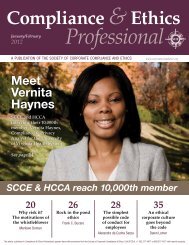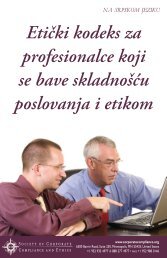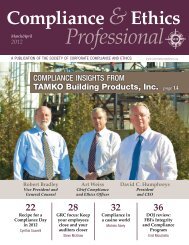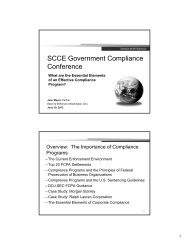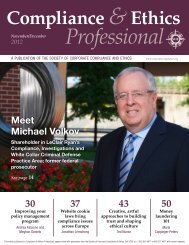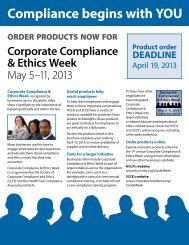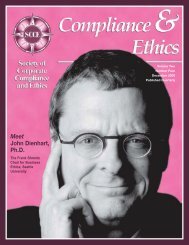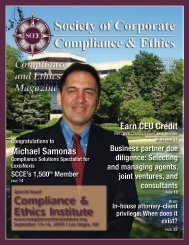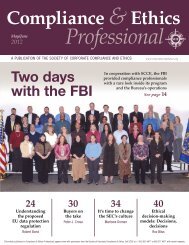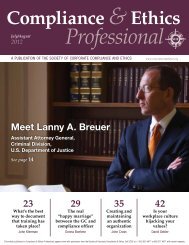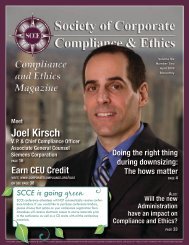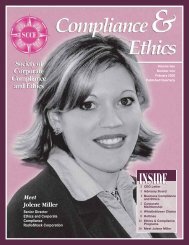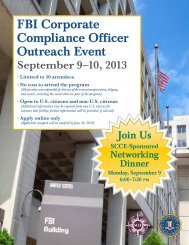y Dan Small <strong>and</strong> Robert F. RoachPowerful witness preparation:Don’t volunteer»»Free-flowing conversations move through a series <strong>of</strong> connections to seemingly unrelated topics.»»Testimony should stick to the question at h<strong>and</strong> <strong>and</strong> stay on a narrow path.»»The questioner’s job is to ask clear questions, not lead the witness into volunteering information that is inadmissible, irrelevant,or just <strong>of</strong>f track.»»Don’t fill the silence—use it to prepare for what lies ahead.»»Volunteer information only if it will clear up a misunderst<strong>and</strong>ing or emphasize a key theme.<strong>Compliance</strong> & <strong>Ethics</strong> Pr<strong>of</strong>essional May/June 2013In this series <strong>of</strong> articles, lead author <strong>and</strong> seasoned trial attorneyDan Small sets forth ten, time-tested rules to assist you in thecritical task <strong>of</strong> preparing witnesses. Robert F. Roach assistedDan in this series by providing additional “in-house” perspective<strong>and</strong> commentary. The first installment <strong>of</strong> this series waspublished in our January/February 2012 issue.Dan <strong>and</strong> Robert will be speaking about investigations atSCCE’s Higher Education Conference, June 2–5, in Austin, TX.Rule 8: Don’t volunteerpause, answer, stop.”That is the unnatural but essential“Question,rhythm <strong>of</strong> an effective witness.We’ve talked about each <strong>of</strong> thesefirst three steps, now we must talk about the“stop.” Don’t volunteer. Like so much <strong>of</strong> beinga witness, this is contrary to what we are usedto—<strong>and</strong> what our goal is—in a free-flowingconversation.The essence <strong>of</strong> conversation is connections.One thought leads to another, <strong>and</strong> the conversation“flows.” Depending on the setting <strong>and</strong>the people, it can me<strong>and</strong>er slowly for hoursor flow swiftly to a conclusion, but it alwayscontinues by means <strong>of</strong> connections. If youare chatting over lunch <strong>and</strong> your companionasks if you saw a recent movie, yourresponse will probably not be a simpleyes or no. Rather, you will go on to talkabout whatever interests you that’sconnected to the original question, orwhatever follows:Q: Did you see movie X withactor Smith?SmallA: Yes, but you know I really likedhim better in movie Y. Theacting was better. Of course,it may just be that the nightI saw that movie was reallymemorable, since Mark almostgot arrested on the way home.The movie went longer thanwe thought, so he was really Roachspeeding on the way home <strong>and</strong>saw this police car just in time. He’s sucha crazy driver; I’m really worried he’sgoing to get in an accident someday.And so on. A conversation that started witha simple question about movie X has quicklyflowed along to Mark the dangerous driver,through a series <strong>of</strong> underst<strong>and</strong>able connections,one subject to another. No one asked aboutMark, or even movie Y; but in a conversation,52 www.corporatecompliance.org +1 952 933 4977 or 888 277 4977
that kind <strong>of</strong> volunteering is all right. As a witness,it is not all right.In the unnatural world <strong>of</strong> being a witness,connections are not the goal. Your job as awitness is generally to insist on clear <strong>and</strong> fairquestions; answer carefully, briefly, <strong>and</strong> precisely;<strong>and</strong> then go home. “Question, pause,answer, stop.” The questioner’s job is to ask theright questions to get at the information he orshe wants. It should not be the questioner’s jobto put words in your mouth. Nor should it beyour job to volunteer information beyond thenarrow lines <strong>of</strong> the question.Connections mean you are volunteering.Don’t do it. You may think that it will somehowhelp or shorten your time as a witness,but it will not. Wait for a clear <strong>and</strong> simplequestion, keep your answer as short, simple,<strong>and</strong> narrow as possible, <strong>and</strong> then stop. If aquestioner does not follow up with more questions,<strong>and</strong> thereby misses other information,that’s not your problem. Your volunteeredaddition may be inadmissible, irrelevant, orjust <strong>of</strong>f track.Think about what this same movie discussionmight look like with a careful witnesswho does not volunteer:Q: Did you see movie X with actor Smith?A: Yes.Q: Did you like it?A: Yes.Q: Have you seen any other movies withactor Smith?A: Yes.Q: Which ones?A: Movie Y.Q: Which movie did you like better, X or Y?A: I’m not sure.And so on. Each question is answeredtruthfully, but you have not done the questioner’sjob for him or her: You have notvolunteered. You have broken the chain <strong>of</strong> connections.“Question, pause, answer, stop.”There are no “shortcuts” here. Answer eachquestion at its most basic level. Do not try to helpthe process along or anticipate where it might begoing. Too <strong>of</strong>ten that means going <strong>of</strong>f that straight<strong>and</strong> narrow path forward. Those kinds <strong>of</strong> sidestepscan take much more time in the long run<strong>and</strong> greatly add to the difficulty <strong>of</strong> being a witness.Your goal should be to give the questionernowhere to go but forward, toward the end.A case in pointSome time ago, author Dan Small representedan investment manager in testimony before theSecurities <strong>and</strong> Exchange Commission (SEC).Through a long day <strong>of</strong> questioning, he did anexcellent job <strong>of</strong> listening carefully <strong>and</strong> keepinghis answers precise <strong>and</strong> simple. Finally, late inthe afternoon, he faltered. He answered a question,stopped, <strong>and</strong> then thought <strong>of</strong> somethingconnected to his answer that he wanted to say.The SEC lawyer, tired <strong>of</strong> having to deal witha careful witness, picked up on his hesitation<strong>and</strong> pushed him to say more. Although it wasactually an insignificant point, the questionerwas so intent on pursuing something that cameout spontaneously, that testimony ended upgoing on <strong>and</strong> on about this new topic for half anhour, before it petered out <strong>and</strong> the questionergot back to the original line <strong>of</strong> questions.At the next break, Dan’s client lookedsheepishly <strong>and</strong> said, “You don’t have to sayanything, I know what I did wrong.” In aneffort to help things along, he had only addedto the process. His “shortcut” had wasted halfan hour that would have been saved by silence.The value <strong>of</strong> silenceNot volunteering means realizing that silence isokay. This is a hard adjustment. In our normallives, silence between people in a conversationmakes us uncomfortable, <strong>and</strong> we try to fill inthe gaps. We all know viscerally what “uncomfortablesilence” is. We don’t like it. Experiencedquestioners know this. They know that silence<strong>Compliance</strong> & <strong>Ethics</strong> Pr<strong>of</strong>essional May/June 2013+1 952 933 4977 or 888 277 4977 www.corporatecompliance.org 53




